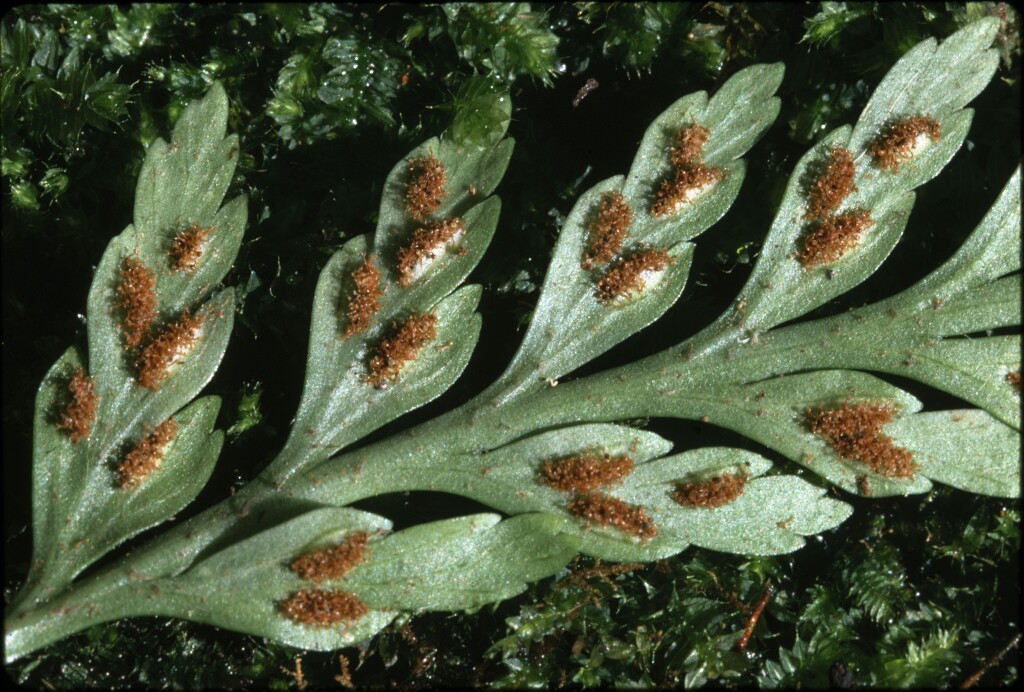Asplenium gracillimum
ColensoRhizome short, thick, covered with ovate-lanceolate, dark brown, translucent scales. Fronds tufted, erect to spreading, mostly 20–120 cm long, usually large and drooping. Stipe shorter than lamina, stout, grooved and green above, dark to almost black on lower surface; scales at base of stipe similar to rhizome scales but with long-tapering tips; scales along stipe, rachises and veins smaller, with broad triangular bases. Lamina ovate to oblong-lanceolate, 2–3-pinnate, often finely divided, pale to dark green, thin-textured (but not membranous); primary rachis with broad central rib between narrow grooves, thickened basal edges of pinnae decurrent along outer edges of groove. Bulbils (which form new plantlets) frequently present on upper surface of lamina, towards tips of pinnae, preceded by a group of dark brown scales on veinlet. Pinnae shortly stalked or sessile, ovate-oblong, often with tapering tips; pinnules elliptic-lanceolate, sessile or with short coarse stalks, obovate to triangular, 4–20 cm long, entire or with shallow lobes, outer margins convex; veins obscure except for raised midveins. Sori short, oblong, submarginal along pinnules or lobes; indusium oblong, firm, membranous.
GleP, VVP, GipP, OtP, CVU, GGr, NIS, EGL, EGU, WPro, HSF, HNF, OtR, Strz, MonT, HFE, VAlp. Also SA, Qld, NSW, Tas. (including Bass Strait islands). New Zealand. Usually found in gullies of rainforest, on logs or tree-fern trunks, among rocks, or near streams and waterfalls.
Asplenium gracillimum has previously been recognised as a subspecies of A. bulbiferum G.Forst. However, A. gracillimum was shown by nuclear DNA sequence data to be an allooctoploid with tetraploid A. bulbiferum and A. hookerianum parents (Shepherd et al. 2008). It is general practice to recognise allopolyploids at the rank of species in fern taxonomy (Barrington et al. 1989), which is why it is here recognised as a separate species. Asplenium bulbiferum is confined to New Zealand. It differs from A. gracillimum in having smaller spores and stipe scales without long-tapering tips and usually has larger fronds with more bulbils (Brownsey & Perrie 2018). In New Zealand A. bulbiferum tends to also grow in wetter habitats than A. gracillimum (Brownsey 1977).
Plants commonly cultivated in Australia under the name Asplenium bulbiferum are A. × lucrosum Perrie & Brownsey, which is a sterile hybrid between A. bulbiferum and Norfolk Island A. dimorphum Kunze (Perrie et al. 2005). Asplenium × lucrosum has aborted spores and is perpetuated by bulbils.
Entwisle, T.J. (1994). Ferns and allied plants (Psilophyta, Lycopodiophyta, Polypodiophyta). In: Walsh, N.G.; Entwisle, T.J., Flora of Victoria Vol. 2, Ferns and Allied Plants, Conifers and Monocotyledons, pp. 13–111. Inkata Press, Melbourne.
 Spinning
SpinningMisapplications
Barrington, D.S.; Haufler, C.H.; Werth, C.R. (1989). Hybridisation, reticulation and species concepts in the ferns. American Fern Journal ** 79**: 55–64.
Brownsey, P.J. (1977). A taxonomic revision of the New Zealand species of Asplenium. *New Zealand Journal of Botany * 15: 39–86.
Brownsey, P.J.; Perrie, L.R. (2018). Aspleniaceae. In: Breitwieser, I.; Wilton, A.D., Flora of New Zealand-Ferns and Lycophytes. Fascicle 18., pp. –. Manaaki Whenua Press, Lincoln.
Ohlsen, D.J. (2020). Asplenium. In: Kodela, P.G., Flora of Australia, pp. –. Australian Biological Resources Study, Canberra.
Shepherd, L.D.; Perrie, L.R.; Brownsey, P.J. (2008). Low-copy nuclear DNA sequences reveal a predominance of allopolyploids in a New Zealand Asplenium fern complex. Molecular Phylogenetics and Evolution 49: 240–248.




